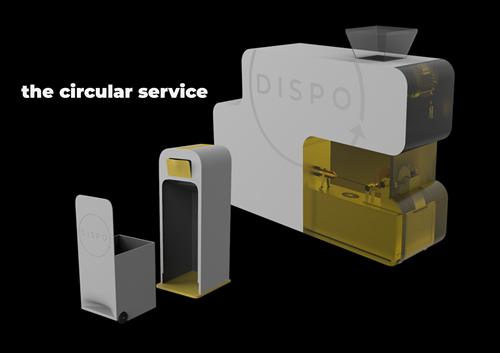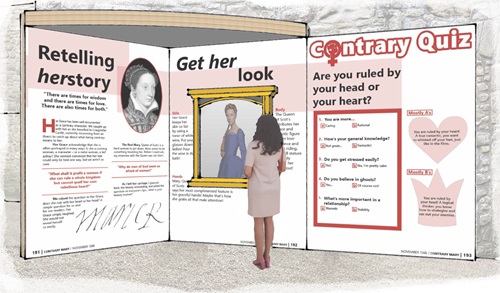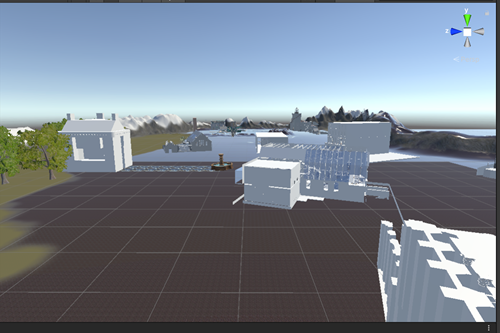We speak to MA/MFA students Margherita Alessandrini, Shona Burns and Suzanne Cathro about their Degree Show projects.
Reducing PPE waste in hospitals
‘Dispo’ aims to reduce PPE masks in 3D printable material directly in hospitals
An Edinburgh Napier design student has developed a product that could see medical grade face masks repurposed as 3D printed items directly within hospitals.
MFA Product Design Making student Margherita Alessandrini has developed ‘Dispo’ – a bin/machine combination that if rolled out could significantly reduce the amount of Protective Personal Equipment (PPE) waste seen in hospitals and other medical facilities.
Margherita has designed a process that could see used PPE quarantined and sterilised before being broken down into a 3D printable material.
Used directly on site, this material could be used to fabricate items such as medical prosthesis for a range of purposes including staff training.
Margherita’s project builds on French research that has developed a process for quarantining and sterilising used PPE so that it is safe to repurpose.
She was inspired to design the process after seeing first-hand the increase in single-use plastic across many industries throughout the last year.
She said: “I spent lockdown in Italy and while working in a restaurant, I became aware that I was really the only person wearing a re-usable mask. There were so many disposable face masks being used, coupled with single-use plastic such as cutlery and plates. Where were all these ending up once they were used?
“Dispo looks at providing a solution to this issue directly within hospitals. The self-contained machine and process could see staff place their used face mask in a safe container, before it is quarantined and sterilised for four days prior to being broken down to a 3D printable filament for use.
“3D print is so popular and is now being regularly used to create lots of items. My initial thoughts could be that it is used within a hospital setting to create prosthesis to help with staff training, amongst having the potential to be used to create other medical care devices.
“Face masks, especially within a hospital setting, are here to stay for some time yet so it’s important we look at ways of countering the growing issue of plastic waste as we move through the pandemic and beyond.”
Margherita’s project will be shown this week as part of Edinburgh Napier’s online Degree Show. The annual event is a showcase of the best and brightest work from the University’s School of Arts and Creative Industries.
More information on her project, Dispo, can be found here.
‘Contrary Mary’ challenges the traditional interpretation of Scotland’s castles
Scotland’s HERitage re-examined
Shona Burns is studying an MA in Design for Heritage & Exhibition at Edinburgh Napier University.
Her final project is an interpretation proposal for Craigmillar Castle, focusing on modern perceptions of Mary, Queen of Scots, called ‘Contrary Mary’.
Throughout history, Mary Queen of Scot’s has been portrayed as a 'difficult' woman. A female leader in a patriarchal society, a practising Catholic in a Protestant country, raised in France but the ruler of Scotland. 
Shona’s proposal explores the dichotomy of Mary’s character through a modern lens, using social media and tabloid headlines to follow her story and the unravelling of her reign, at the hands of her own council.
Shona said: “When I was doing the research for the project I asked myself: ‘Have I ever been to castle or heritage site where women have been discussed at all?
“I couldn’t think of anywhere apart from when they’d discuss what the cook prepared, for example.”
Recent research has raised questions about whether Mary was ever involved in the plot to kill her then husband and has suggested that her own counsel were working against her as they didn’t want a Catholic woman in power.
Shona added: “A lot of history has been destroyed or tailored to suit a narrative.”
In consultation with Historic Environment Scotland and tutors, Shona’s interpretation of Craigmillar Castle allows visitors to follow Mary’s story and ultimately answer the question: ‘what do you think Mary would have been like if she were alive today?’
Do you think she would have been a feminist revolutionary; do you think she would have been a driven career woman? A stay-at-home mum…?
A virtual Degree Show for Interior and Spatial Design students
From small-scale models to an immersive experience
Suzi Cathro has developed an online immersive space to showcase final year students’ work from the Interior and Spatial Design course at Edinburgh Napier University.
The space will allow anyone to enter a virtual world, walk around the environment and explore buildings created by students - as though they were in real life. 
Suzi, who is currently studying an MA for Design for Interactive Art and Experience, was studying her undergraduate degree at Edinburgh Napier last year when the pandemic hit, she said:
“For me, it was completely natural to stick with Napier. With everything being so uncertain, it was reassuring to know that the staff here are outrageously supportive, so inspiring and willing to give you the tools you need to succeed.”
Suzi was inspired to create a space where friends, family and potential employers can access and celebrate students’ work:
“This project was born from my experiences as a 4th year undergraduate at Edinburgh Napier who did not get to showcase their work due to the pandemic.
“It really upset me not being able to show my work, and missing out on showing employers what you can do.”
Suzi has been working with staff from Interior and Spatial Design to ensure that students are able to display their work – it's hoped that this format will be taken forward post-pandemic, allowing the students to more fully realise their ideas beyond a small-scale model.